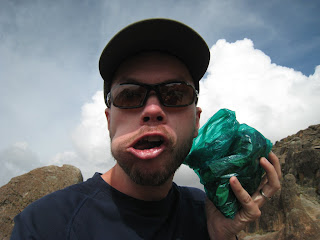
Jungle fever! Being this close to the Amazon, we couldn`t resist a short foray into its green and rainy depths. Landing on a grassy landing strip in Rurrenebaque, our oxygen-deprived lungs breathed a happy sigh of relief at the low altitude, and we joyfully stripped off layers of fleece. The next morning, we motored up the fast-moving cappuccino-colored waters of an Amazon tributary to Chalalan Ecolodge.

This place got big props from fellow travelers and rave reviews from the Lonely Planet, so we dug deep in our wallets to enjoy three glorious nights in jungle splendor.
Chalalan's accolades are well merited, one of the few truly community-run eco-lodges in this rare swath of the Amazon, Chalalan makes the most of it's local flavor. Started in the 1990's by the neighboring community of San Jose De Uchupiamonas (say that three times fast), Chalalan is built by locals, with local materials, uses local guides, and proceeds have already funded a school and medical clinic. It's a beautiful spot and one of the few places where you can actually stay in Madidi National Park, near relatively untouched rainforest.

We had a little paradisaical cabana with a requisite hammock out front, and we spent our days tromping through the National Park and sweating our way through our limited supply of clean clothes. Twilight meant beer and sunset swims in the Chalalan lake, braving the hopefully-sated appetites of the resident caymans. It was kind of funny to jump headfirst into the dark, but blissfully refreshing, water at dusk only to don headlamps and search for flesh-eating aquatic reptiles along the shore mere hours later. Really, that's only a slight exaggeration.

Our first night walk started with a hunt for the elusive boa constrictor. And admittedly some part of us perhaps wanted him to remain hidden. Particularly disconcerting was the fact that our search began in one of the lodge's main buildings, where evidently boa's like to congregate in the rafters. Ahem. We did find one in a tree nearby. And during the day spotted capuchin monkeys, spider monkeys, all sorts of spiders, and...the grand pooh-bah...a giant ant-eater! While giant ant-eater might not conjure up the same awe as seeing, say, a snow leopard or jaguar, it is a super impressive (and big!) animal to witness in the wild. Our guide had never seen a full-grown one before (and he grew up in the jungle), so he was foaming at the mouth with excitement. And no, sadly, we do not have a photo. Doh!

Perhaps in our best interest we did not see the bushmaster snake. This fella is particularly notable for the fact that if you threaten his awaiting-to-be-hatched eggs at any point, and even if you do so completely unwittingly by walking down a jungle trail, this snake will follow you for up to 500 meters before striking. And likely killing you. Fun facts to have in the back of your mind as you stumble through the steamy jungle.

By far our favorite animal, though, was the capybara, the world's largest rodent. He's endearing in a way that only the world's largest rodent could be. We're thinking this will be the focal point of the best-selling children's book we plan to write and illustrate in our free time.
Truth be told, jungle walks searching for animals can be really rather boring unless you really know your trees and plants. It's 10,000 degrees out. You're covered in way too much long-sleeved, long-panted clothing to keep from getting rare jungle rashes and bites, your sunscreen mixes with bugspray in your eyes, and it feels like you're trying to exercise in a sauna. And the scenery is pretty unchanging.

On the positive side, we were lucky enough to be lumped in with a group of fun-loving souls in our jungle paradise. And coca-leaf chewing, leche-de-puma drinking, and awkward dance events were made all the more delightful by the company we kept. This extends wholeheartedly to the entire Chalalan staff. Many of whom joined us in a hilarious tri-lingual game of cards on our last night. Explaining the game Bullsh#$%#t in English, Spanish, and Quechua was a cultural experience not to be forgotten (no, really, if you don't have the card, just lie, that's what you're supposed to do!).
 How can it be that our year is over? Alas, all good things must come to an end. Or at least a temporary hiatus until our next adventure.
How can it be that our year is over? Alas, all good things must come to an end. Or at least a temporary hiatus until our next adventure. 


















































